IDA-Based Seismic Fragility Analysis of a Concrete-Filled Square Tubular Frame
Abstract
1. Introduction
2. Structural Modeling of CFST Frames
2.1. Structural Design
2.2. Experimental Verification and Modeling Method
2.3. Model Establishment
3. Incremental Dynamic Analysis
3.1. Ground Motion Selection
3.2. Selection of IM and DM
3.3. Analysis and Discussion of IDA Results
3.3.1. IDA Curve Clusters of In-Plane Frame
3.3.2. IDA Curve Clusters of Spatial Frame Subjected to 1D Ground Motions
3.3.3. IDA Curve Clusters of Spatial Frame Subjected to 2D Ground Motions Considering Attacking Angle
4. Seismic Fragility Analysis
4.1. Probabilistic Seismic Demand Model (PSDM)
4.2. Seismic Fragility Curves
4.3. Effect of the Attacking Angle on Seismic Fragility
4.4. The Comparison of Fragility Analysis Curves of CFST Plane Frame and Spatial Frame
5. Conclusions
- (1)
- For the CFST spatial frame under 2D ground motions, the seismic fragility analysis result was found to be sensitive to the attacking angle of ground motion, where the exceeding probability of the 15°, 30°, and 45° fragility curves at the levels LS1–LS3 was close to that of the 0° fragility curves, the exceeding probability of the 60°–90° fragility curves at the levels LS1–LS3 was larger than that of the 0° fragility curves, and the exceeding probability of the 135°, 150°, and 165° fragility curves was larger than that of the 0° fragility curves at each performance level.
- (2)
- The results of the seismic fragility analysis of the spatial frame were obviously different from those of the plane frame. The analytical results showed that the exceeding probability of the spatial frame under 2D ground motions was successively greater than that under 1D ground motions, and greater than the plane frame, and the maximum difference at each performance level was up to 6% and 16%, respectively.
- (3)
- IDA-based seismic fragility analysis of CFST frames should adopt the spatial frame model and consider the effect of the attacking angle of 2D ground motions, rather than the plane frame model.
Author Contributions
Funding
Data Availability Statement
Conflicts of Interest
References
- Cheng, Y.; Dong, Y.-R.; Bai, G.-L.; Wang, Y.-Y. IDA-based seismic fragility of high-rise frame-core tube structure subjected to multi-dimensional long-period ground motions. J. Build. Eng. 2021, 43, 102917. [Google Scholar] [CrossRef]
- Rajkumari, S.; Thakkar, K.; Goyal, H. Fragility analysis of structures subjected to seismic excitation: A state-of-the-art review. Structures 2022, 40, 303–316. [Google Scholar] [CrossRef]
- Wang, J.; Sun, Y. Seismic fragility and post-earthquake reparability of concrete frame with low-bond high-strength reinforced concrete column. Structures 2022, 37, 185–202. [Google Scholar] [CrossRef]
- Rezaei, H.; Zarfam, P.; Golafshani, E.M.; Amiri, G.G. Seismic fragility analysis of RC box-girder bridges based on symbolic regression method. Structures 2022, 38, 306–322. [Google Scholar] [CrossRef]
- Jia, D.-W.; Wu, Z.-Y. Seismic fragility analysis of RC frame-shear wall structure under multidimensional performance limit state based on ensemble neural network. Eng. Struct. 2021, 246, 112975. [Google Scholar] [CrossRef]
- Bao, C.; Ma, X.; Lim, K.S.; Chen, G.; Xu, F.; Tan, F.; Hamid, N.H.A. Seismic fragility analysis of steel moment-resisting frame structure with differential settlement. Soil Dyn. Earthq. Eng. 2021, 141, 106526. [Google Scholar] [CrossRef]
- Xu, C.; Guo, C.; Xu, Q.; Yang, Z. The global collapse resistance capacity of a seismic-damaged SRC frame strengthened with an enveloped steel jacket. Structures 2021, 33, 3433–3442. [Google Scholar] [CrossRef]
- Vasileiadis, V.; Kostinakis, K.; Athanatopoulou, A. Story-wise assessment of seismic behavior and fragility analysis of R/C frames considering the effect of masonry infills. Soil Dyn. Earthq. Eng. 2023, 165, 107714. [Google Scholar] [CrossRef]
- Mansouri, I.; Hu, J.W.; Shakeri, K.; Shahbazi, S.; Nouri, B. Assessment of seismic vulnerability of steel and RC moment buildings using HAZUS and statistical methodologies. Discret. Dyn. Nat. Soc. 2017, 2017, 2698932. [Google Scholar] [CrossRef]
- Qu, Z.; Ye, L.; Pan, P. Comparative study on methods of selecting earthquake ground motions for nonlinear time history analyses of building structures. China Civ. Eng. J. 2011, 44, 10–21. [Google Scholar]
- Yang, F.; Gao, X.; Zhang, W. Rasponse of tall-building steel structure to muti-dimensional seismic action. J. Build. Struct. 2003, 24, 33–43. [Google Scholar]
- Kostinakis, K.; Morfidis, K.; Xenidis, H. Damage response of multistorey r/c buildings with different structural systems subjected to seismic motion of arbitrary orientation. Earthq. Eng. Struct. Dyn. 2015, 44, 1919–1937. [Google Scholar] [CrossRef]
- Lagaros, N.D. Multicomponent incremental dynamic analysis considering variable incident angle. Struct. Infrastruct. Eng. 2010, 6, 77–94. [Google Scholar] [CrossRef]
- GB50936-2014; Technical Code for Concrete Filled Steel Tubular Structures. Ministry of Housing and Urban-Rural Development of the People’s Republic of China: Beijing, China, 2014.
- JGJ138-2016; Code for the Design of Composite Structures. Ministry of Housing and Urban-Rural Development of the People’s Republic of China: Beijing, China, 2016.
- Liu, X.; Xu, C.; Peng, S.; Zhou, B. Influence of staggered floor and unequal height of left and right beam on seismic behavior of CFSST column-to-HSS beam composite frames. J. Build. Eng. 2023, 66, 105878. [Google Scholar] [CrossRef]
- Wang, K.; Lu, X.-F.; Yuan, S.-F.; Cao, D.-F.; Chen, Z.-X. Analysis on hysteretic behavior of composite frames with concrete-encased CFST columns. J. Constr. Steel Res. 2017, 135, 176–186. [Google Scholar] [CrossRef]
- Zhang, Z.; Wang, J.; Li, B.; Zhao, C. Seismic tests and numerical investigation of blind-bolted moment CFST frames infilled with thin-walled SPSWs. Thin Walled Struct. 2019, 134, 347–362. [Google Scholar] [CrossRef]
- Chen, J.; Bian, Y.; Su, L. Application of OpenSees on calculating lateral force-displacement hysteretic curves of concrete-filled steel tubular frame with unequal spans. World Earthq. Eng. 2021, 37, 111–118. [Google Scholar]
- Xu, C.; Deng, J.; Peng, S.; Li, C. Seismic fragility analysis of steel reinforced concrete frame structures based on different engineering demand parameters. J. Build. Eng. 2018, 20, 736–749. [Google Scholar] [CrossRef]
- GB/T50011-2010; Code for Seismic Design of Buildings. Ministry of Housing and Urban-Rural Development of the People’s Republic of China: Beijing, China, 2024.
- Karafagka, S.; Fotopoulou, S.; Pitilakis, D. Fragility assessment of non-ductile RC frame buildings exposed to combined ground shaking and soil liquefaction considering SSI. Eng. Struct. 2021, 229, 111629. [Google Scholar] [CrossRef]
- Research on Seismic Behavior and Design Method of Composite Frame with Reinforced Concrete Columns and Steel Beams; Xi’an University of Architecture and Technology: Xi’an, China, 2014.
- Jalali, S.A.; Amini, A.; Mansouri, I.; Hu, J.W. Seismic collapse assessment of steel plate shear walls considering the mainshock–aftershock effects. J. Constr. Steel Res. 2021, 182, 106688. [Google Scholar] [CrossRef]
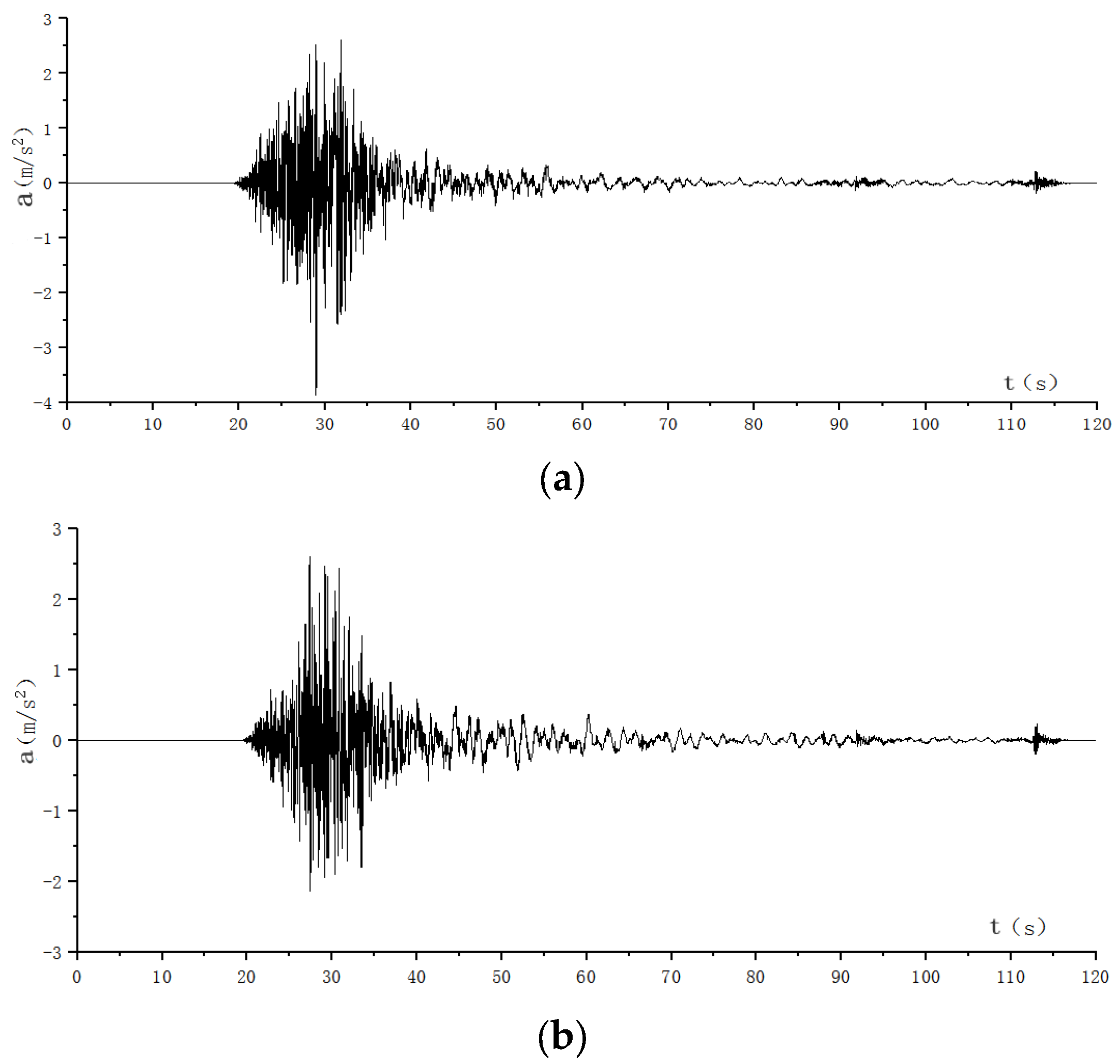

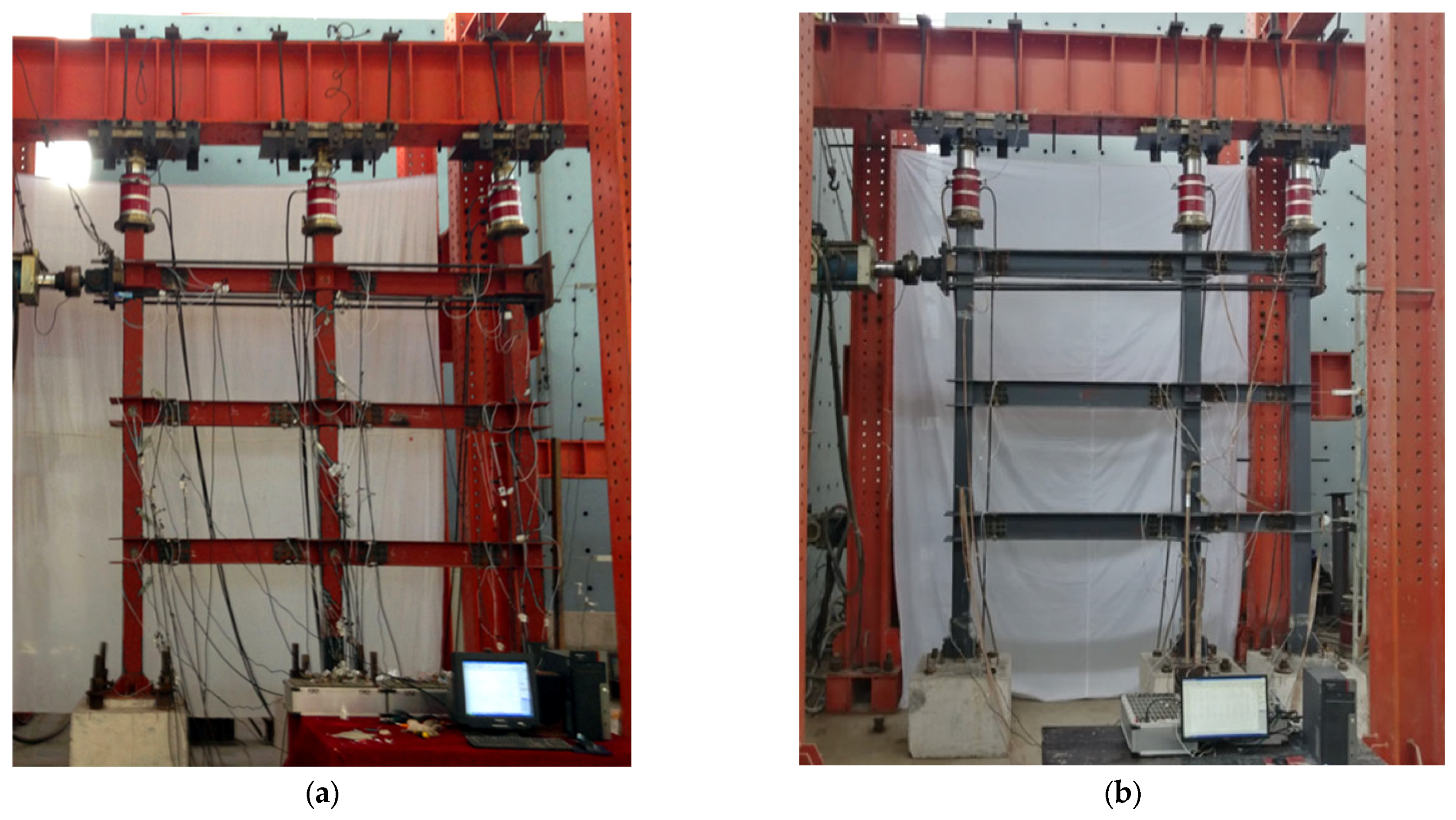
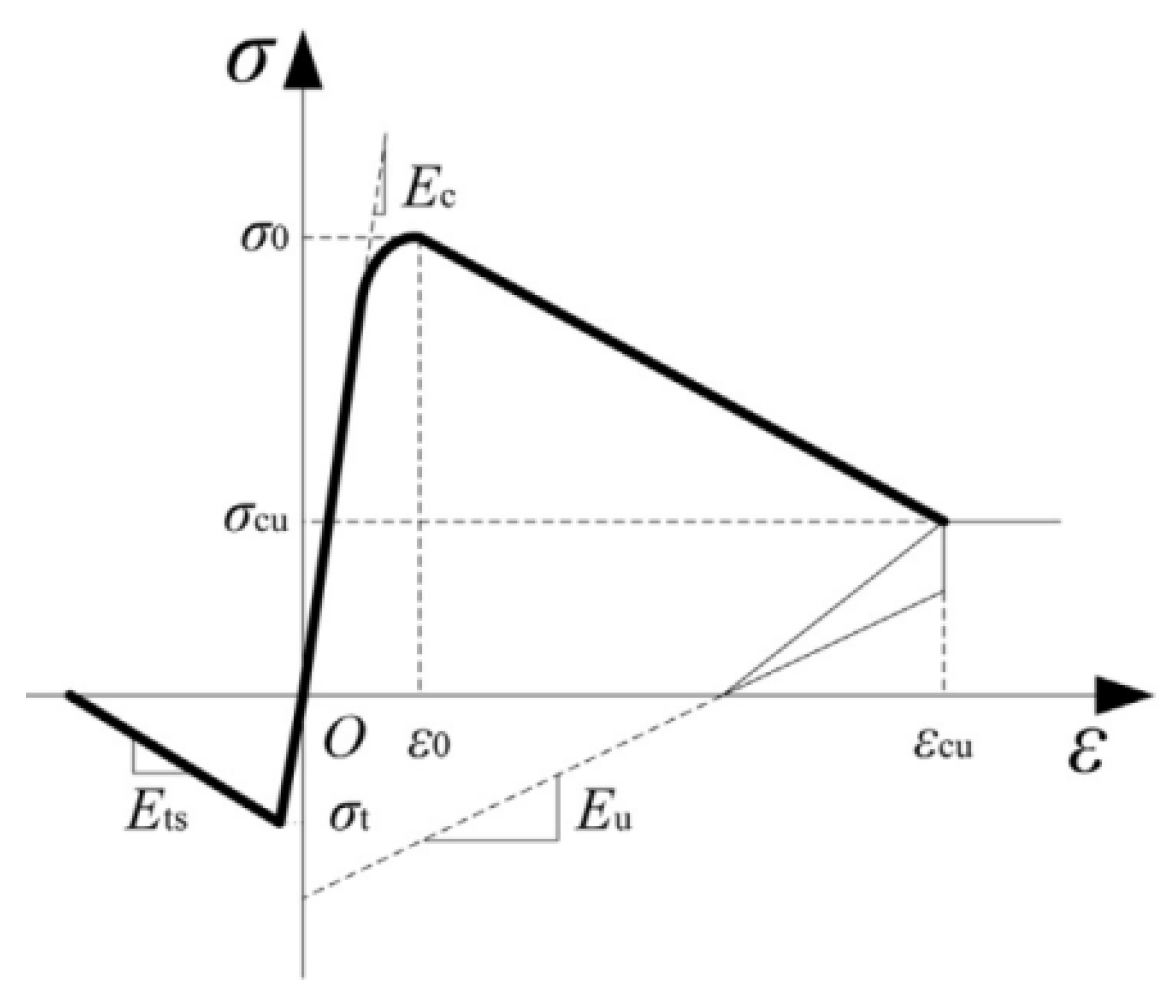
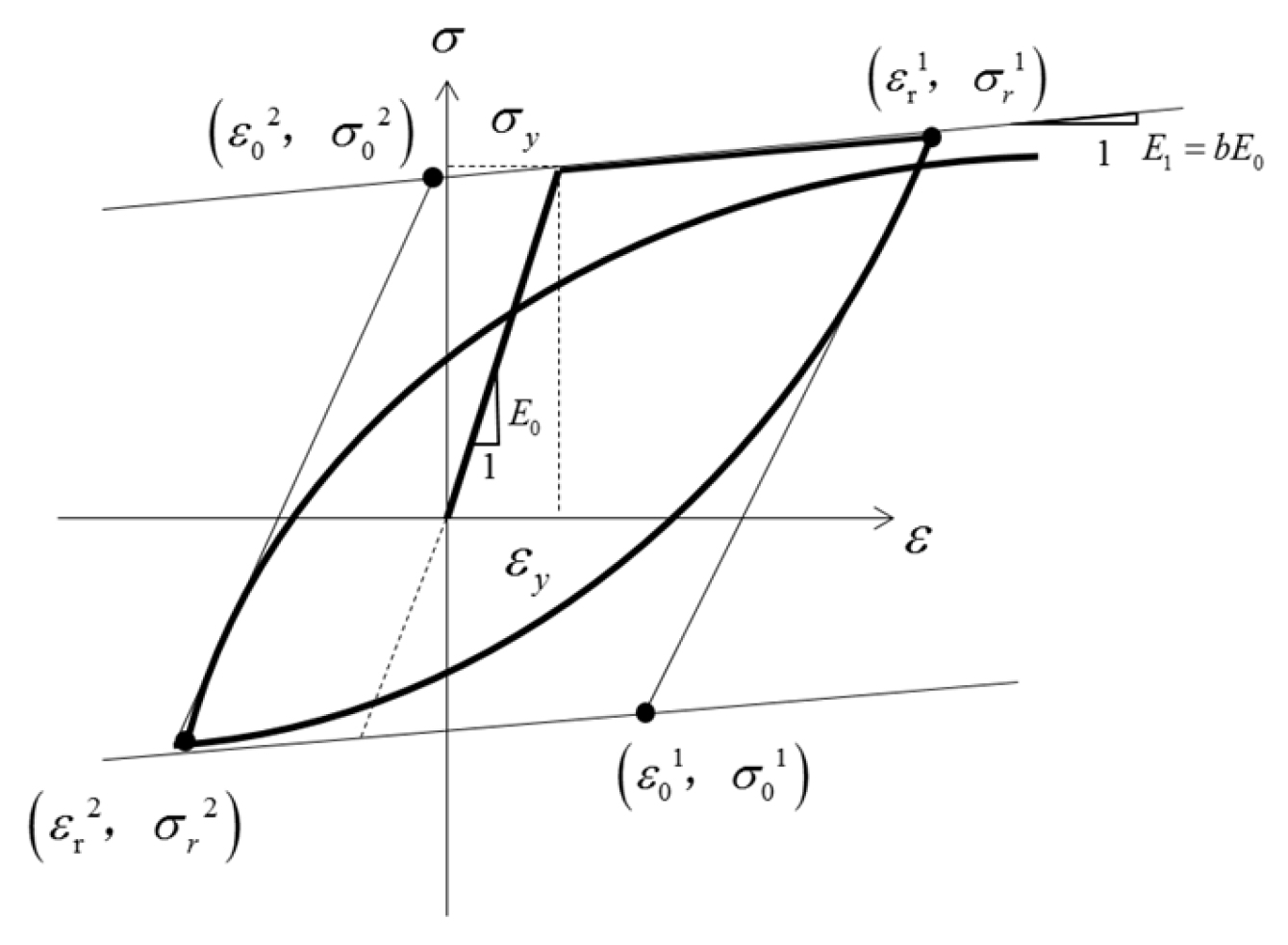


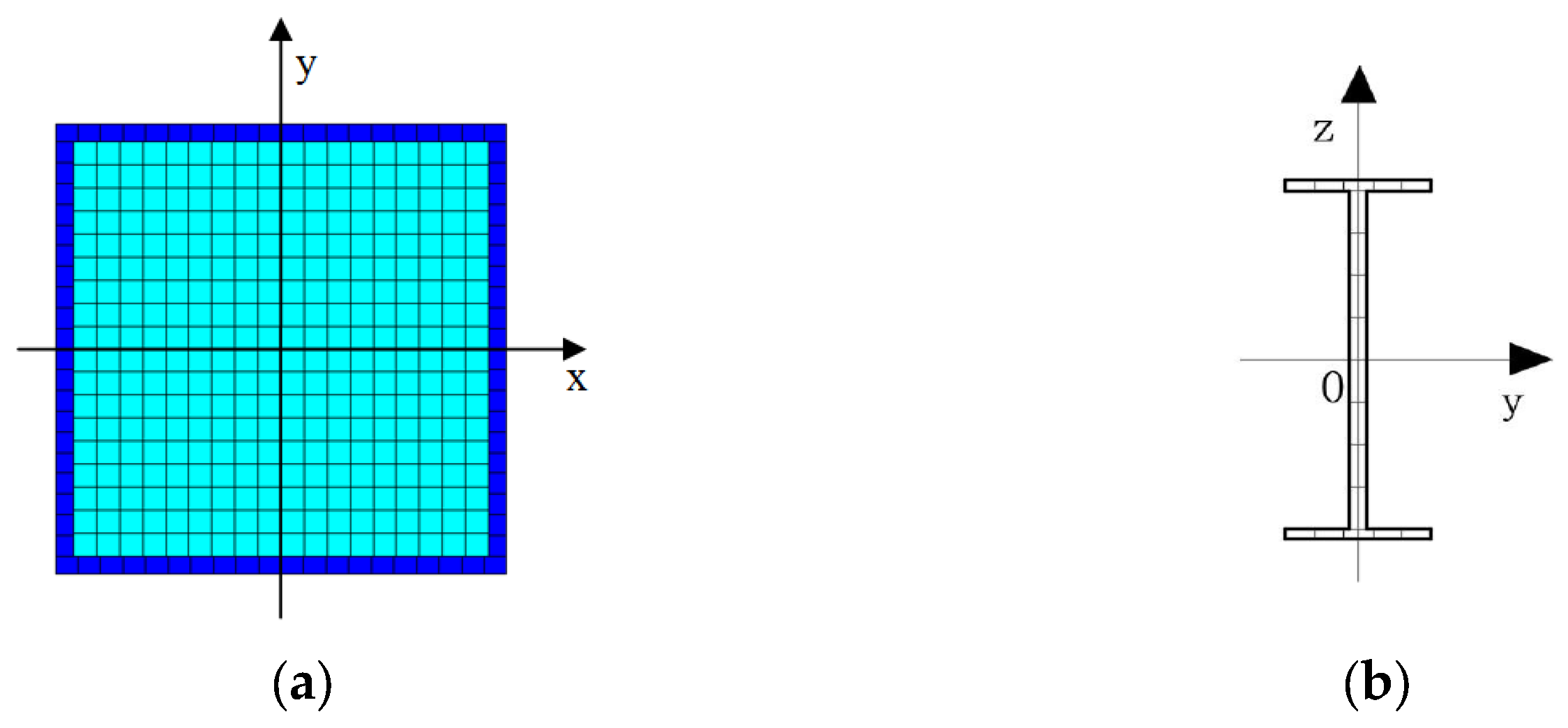
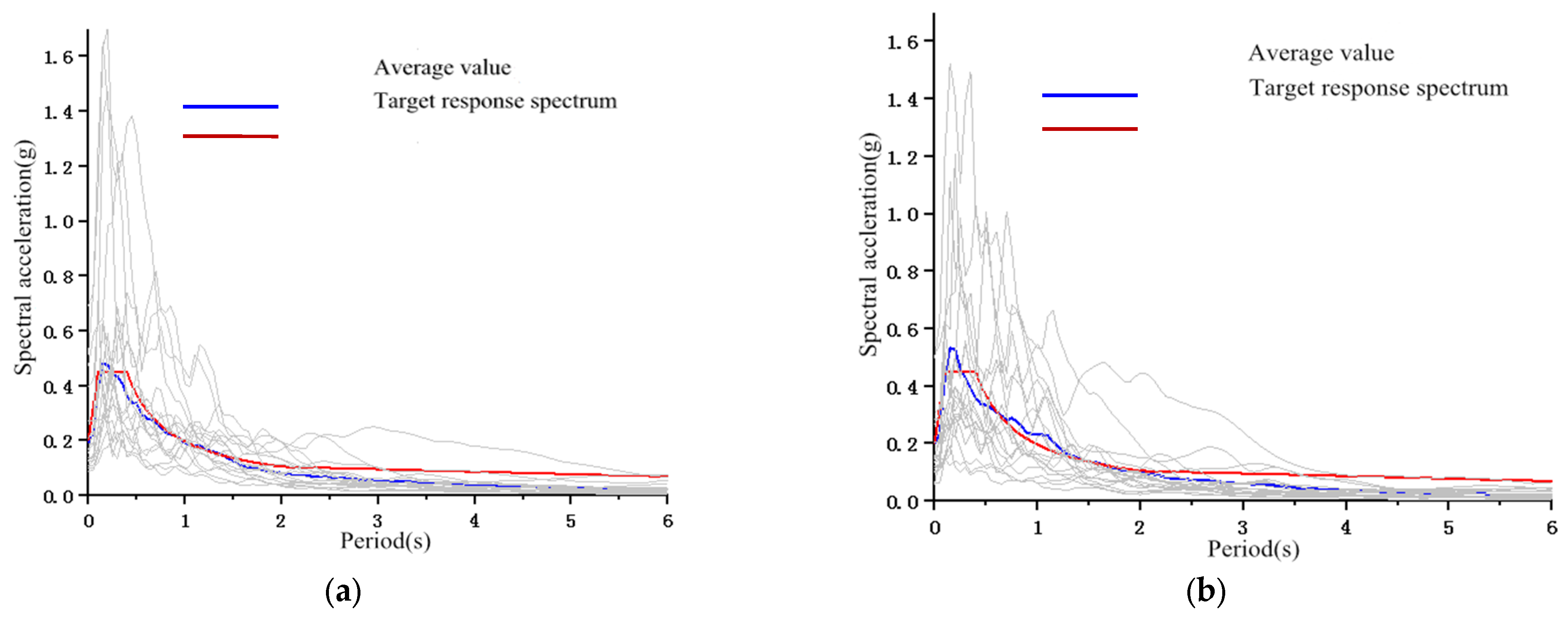
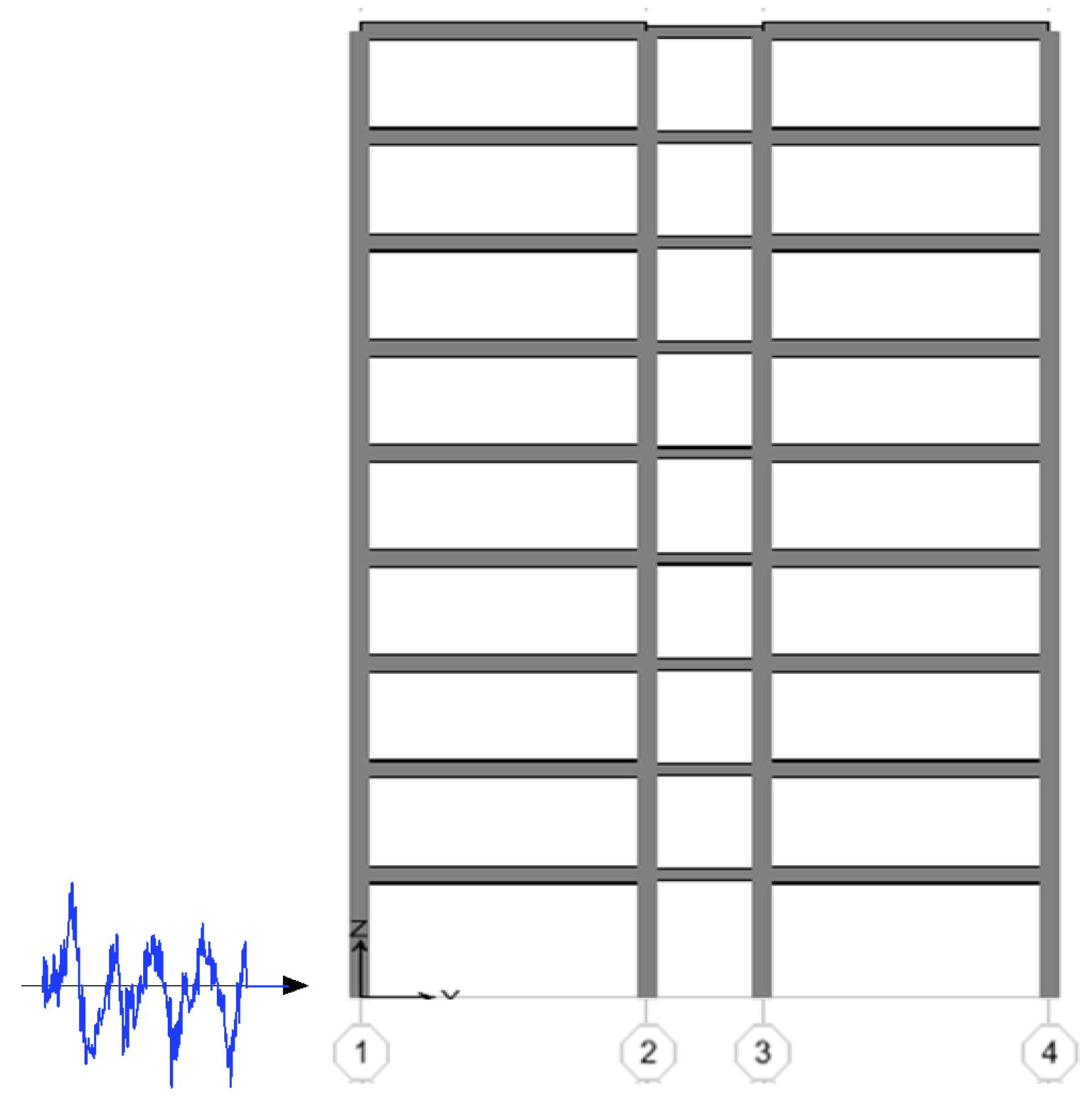




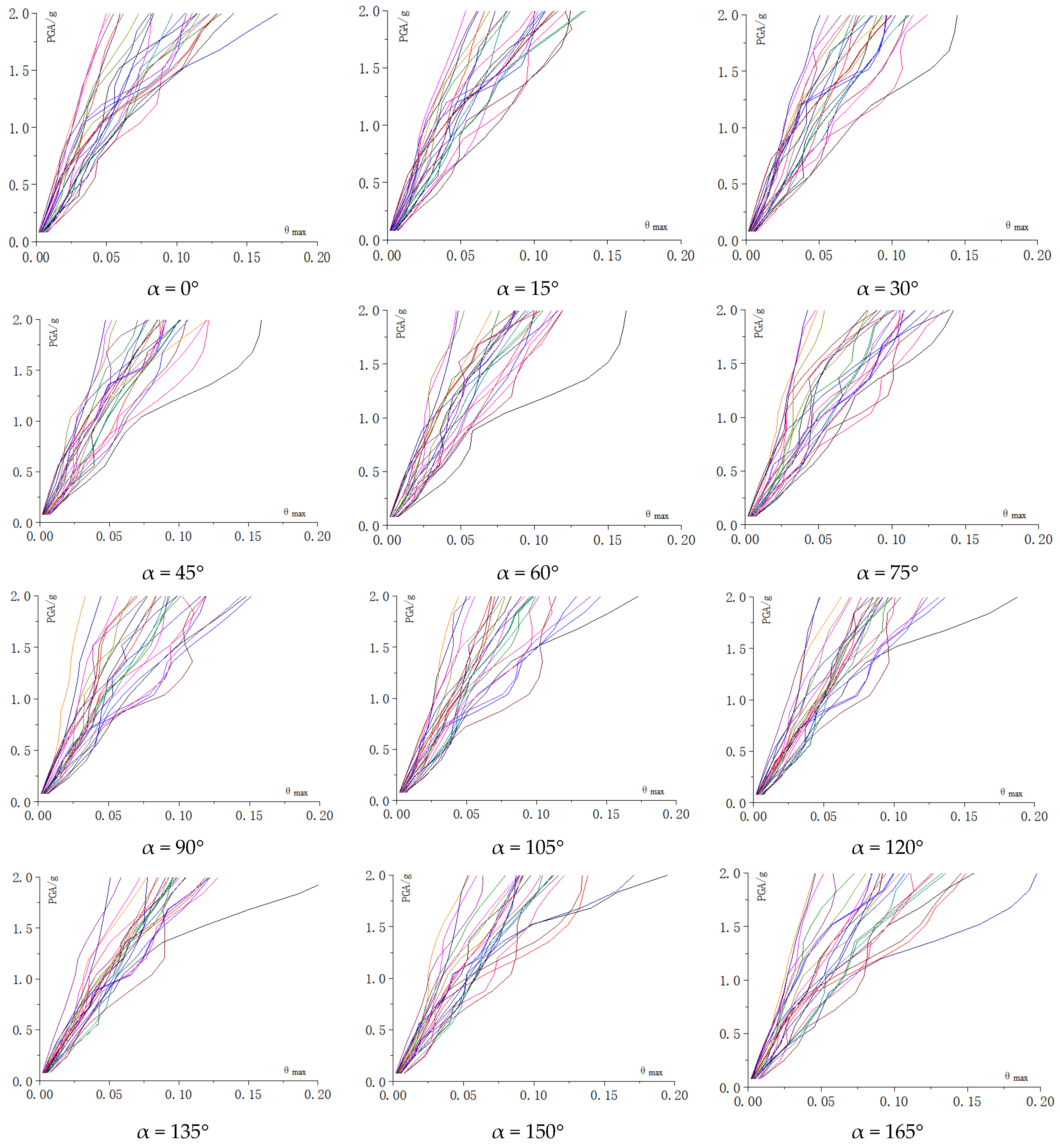
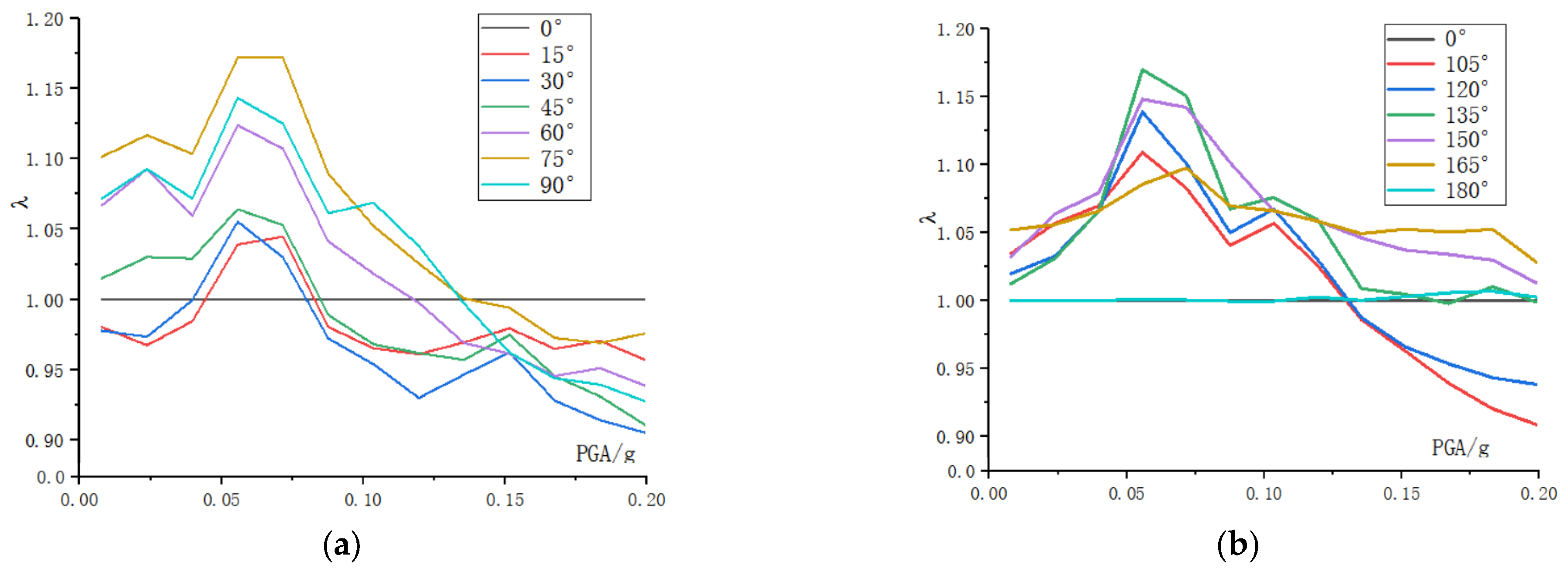
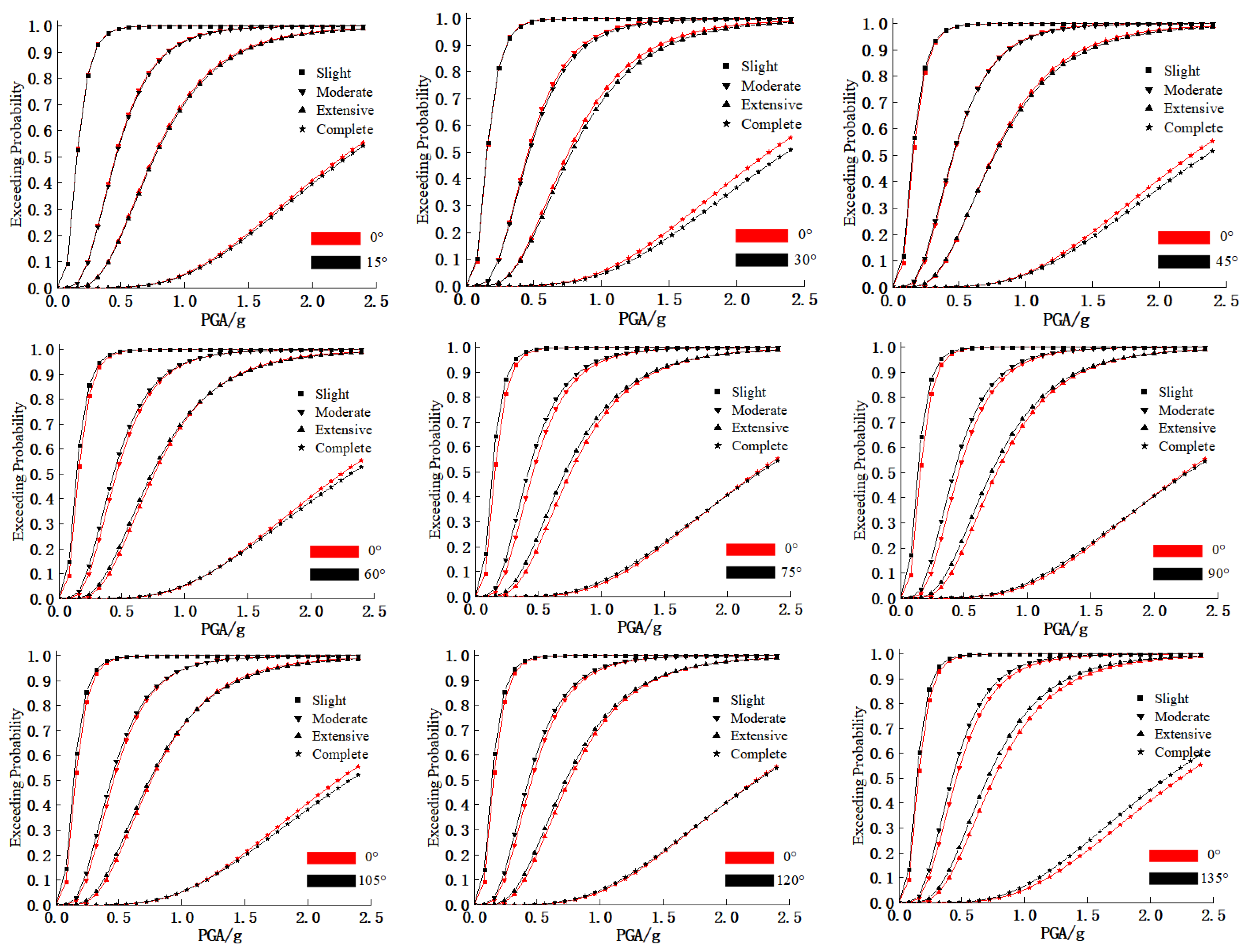

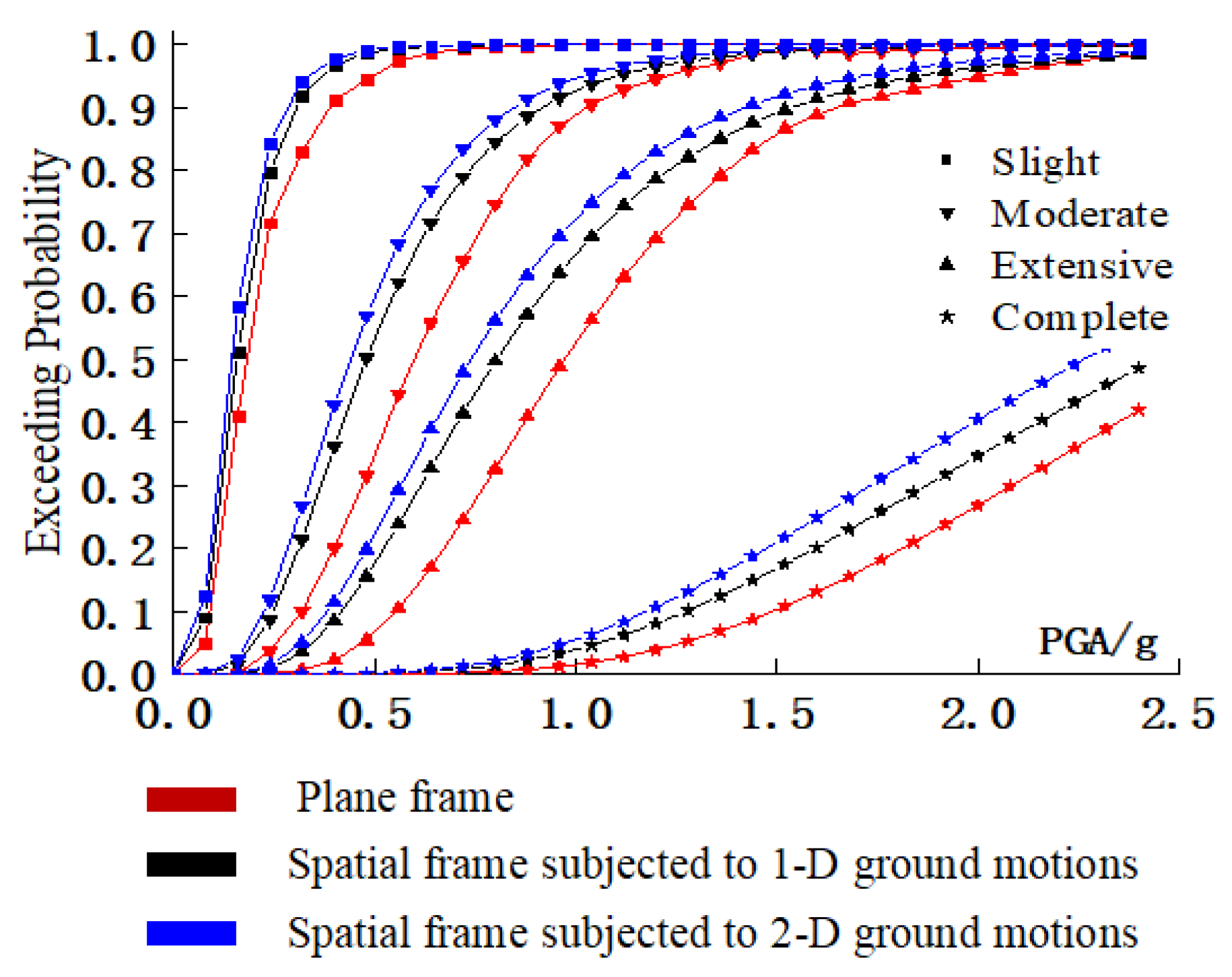
| Component | Section/mm | Steel Specification | Concrete Strength Grade |
|---|---|---|---|
| Steel beam | H600 × 200 × 8 × 12 | Q345 | - |
| H400 × 180 ×6 × 10 | Q345 | - | |
| CFST Column | □500 × 500 × 20 | Q345 | C40 |
| Record | Earthquake Name | Year | Platform | MW | Ground Motion Horizontal Component, N/E |
|---|---|---|---|---|---|
| 1 | “Hollister-01” | 1961 | Hollister City Hall | 5.6 | RSN26_HOLLISTR_B-HCH181/271 |
| 2 | “San Fernando” | 1971 | Santa Felita Dam (Outlet) | 6.61 | RSN88_SFERN_FSD172/262 |
| 3 | “Imperial Valley-06” | 1979 | “Cerro Prieto” | 6.53 | RSN164_IMPVALL.H_H-CPE147/237 |
| 4 | “Irpinia_ Italy-01” | 1980 | “Bisaccia” | 6.9 | RSN286_ITALY_A-BIS000/270 |
| 5 | “Chalfant Valley-02” | 1986 | “Long Valley Dam (Downst)” | 6.19 | RSN553_CHALFANT.A_A-LVD000/090 |
| 6 | “Chalfant Valley-02” | 1986 | “Long Valley Dam (L Abut)” | 6.19 | RSN554_CHALFANT.A_A-LVL000/090 |
| 7 | “Loma Prieta” | 1989 | Coyote Lake Dam—Southwest Abutment | 6.93 | RSN755_LOMAP_CYC195/285 |
| 8 | “Manjil_ Iran” | 1990 | Abbar | 7.37 | RSN1633_MANJIL_ABBAR--L/T |
| 9 | “Cape Mendocino” | 1992 | Fortuna—Fortuna Blvd | 7.01 | RSN827_CAPEMEND_FOR000/090 |
| 10 | “Cape Mendocino” | 1992 | Loleta Fire Station | 7.01 | RSN3750_CAPEMEND_LFS270/360 |
| 11 | “Landers” | 1992 | North Palm Springs Fire Sta #36 | 7.28 | RSN3757_LANDERS_NPF090/180 |
| 12 | “Chi-Chi_ Taiwan” | 1999 | “TCU075” | 7.62 | RSN3471_CHICHI.06_TCU075 E/N |
| 13 | “Duzce_ Turkey” | 1999 | “Lamont 1061” | 7.14 | RSN1614_DUZCE_1061-N/E |
| 14 | “Chi-Chi_ Taiwan-06” | 1999 | “TCU075” | 6.3 | RSN3471_CHICHI.06_TCU075N/E |
| 15 | “San Simeon_ CA” | 2003 | San Antonio Dam—Toe | 6.52 | RSN4013_SANSIMEO_36258021/111 |
| 16 | “Chuetsu-oki_ Japan” | 2007 | “Kawaguchi” | 6.8 | RSN4869_CHUETSU_65042NS/EW |
| 17 | “Chuetsu-oki_ Japan” | 2007 | “Ojiya City” | 6.8 | RSN4882_CHUETSU_65321NS/EW |
| 18 | “Chuetsu-oki_ Japan” | 2007 | “NIG024” | 6.8 | RSN5270_CHUETSU_NIG024NS/EW |
| 19 | “Chuetsu-oki_ Japan” | 2007 | Matsushiro Tokamachi | 6.8 | RSN4843_CHUETSU_65006NS/EW |
| 20 | “Chuetsu-oki_ Japan” | 2007 | Joetsu Ogataku | 6.8 | RSN4848_CHUETSU_65011NS/EW |
| 21 | “Chuetsu-oki_ Japan” | 2007 | Sawa Mizuguti Tokamachi | 6.8 | RSN4872_CHUETSU_65053NS/EW |
| 22 | “Iwate_ Japan” | 2008 | “Yuzawa Town” | 6.9 | RSN5806_IWATE_55461NS/EW |
| 23 | “Iwate_ Japan” | 2008 | “Kami_ Miyagi Miyazaki City” | 6.9 | RSN5776_IWATE_54010NS/EW |
| 24 | “Darfield_ New Zealand” | 2010 | “SPFS” | 7 | RSN6971_DARFIELD_SPFSN17E/73W |
| 25 | “Christchurch_ New Zealand” | 2011 | “MQZ” | 6.2 | RSN8110_CCHURCH_MQZE/ZN |
| Damage State | Slight Damage (LS1) | Moderate Damage (LS2) | Extensive Damage (LS3) | Complete Damage (LS4) |
|---|---|---|---|---|
| θmax | 1/150 | 1/50 | 1/30 | 1/10 |
| Structure | Ground Motions | Attacking Angle | The Linear Regression Formula |
|---|---|---|---|
| Plane frame subjected to 1D ground motions | 25(N) | 0° | ln(EDP) = 1.133238ln(IM) − 3.69704 |
| 25(E) | 0° | ln(EDP) = 1.093857ln(IM) − 3.599816 | |
| 50(25N + 25E) | 0° | ln(EDP) = 1.113548ln(IM) − 3.648429 | |
| Spatial frame subjected to 1D ground motions | 25(N) | 0° | ln(EDP) = 1.015568ln(IM) − 3.445141 |
| 25(E) | 0° | ln(EDP) = 0.9599472ln(IM) − 3.364997 | |
| 50(25N + 25E) | 0° | ln(EDP) = 0.9875820ln(IM) − 3.405069 | |
| Spatial frame subjected to 2D ground motions | 25N + 25E | 0° | ln(EDP) = 1.011276ln(IM) − 3.343988 |
| 25N + 25E | 15° | ln(EDP) = 1.006654ln(IM) − 3.356569 | |
| 25N + 25E | 30° | ln(EDP) = 0.986977ln(IM) − 3.37602 | |
| 25N + 25E | 45° | ln(EDP) = 0.975368ln(IM) − 3.354419 | |
| 25N + 25E | 60° | ln(EDP) = 0.958666ln(IM) − 3.321175 | |
| 25N + 25E | 75° | ln(EDP) = 0.952800ln(IM) − 3.293288 | |
| 25N + 25E | 90° | ln(EDP) = 0.946490ln(IM) − 3.317331 | |
| 25N + 25E | 105° | ln(EDP) = 0.958472ln(IM) − 3.328774 | |
| 25N + 25E | 120° | ln(EDP) = 0.973446ln(IM) − 3.310517 | |
| 25N + 25E | 135° | ln(EDP) = 0.995960ln(IM) − 3.275722 | |
| 25N + 25E | 150° | ln(EDP) = 0.995817ln(IM) − 3.273766 | |
| 25N + 25E | 165° | ln(EDP) = 1.001221ln(IM) − 3.295428 | |
| 25N + 25E | 180° | ln(EDP) = 1.012651ln(IM) − 3.342390 | |
| (25N + 25E) × 13 | All | ln(EDP) = 0.981602ln(IM) − 3.32366 |
| Damage State | ||||
|---|---|---|---|---|
| LS1 | LS2 | LS3 | LS4 | |
| Plane frame | 0.586 | 0.019 | 0.002 | 0 |
| Spatial frame subjected to 1D ground motions | 0.667 | 0.051 | 0.005 | 0 |
| Spatial frame subjected to 2D ground motions | 0.735 | 0.072 | 0.008 | 0 |
| Damage State | ||||
|---|---|---|---|---|
| LS1 | LS2 | LS3 | LS4 | |
| Plane frame | 0.806 | 0.083 | 0.004 | 0 |
| Spatial frame subjected to 1D ground motions | 0.890 | 0.182 | 0.0285 | 0 |
| Spatial frame subjected to 2D ground motions | 0.919 | 0.228 | 0.0416 | 0 |
Disclaimer/Publisher’s Note: The statements, opinions and data contained in all publications are solely those of the individual author(s) and contributor(s) and not of MDPI and/or the editor(s). MDPI and/or the editor(s) disclaim responsibility for any injury to people or property resulting from any ideas, methods, instructions or products referred to in the content. |
© 2024 by the authors. Licensee MDPI, Basel, Switzerland. This article is an open access article distributed under the terms and conditions of the Creative Commons Attribution (CC BY) license (https://creativecommons.org/licenses/by/4.0/).
Share and Cite
Liu, X.; Xu, C. IDA-Based Seismic Fragility Analysis of a Concrete-Filled Square Tubular Frame. Buildings 2024, 14, 2686. https://doi.org/10.3390/buildings14092686
Liu X, Xu C. IDA-Based Seismic Fragility Analysis of a Concrete-Filled Square Tubular Frame. Buildings. 2024; 14(9):2686. https://doi.org/10.3390/buildings14092686
Chicago/Turabian StyleLiu, Xiaoqiang, and Chengxiang Xu. 2024. "IDA-Based Seismic Fragility Analysis of a Concrete-Filled Square Tubular Frame" Buildings 14, no. 9: 2686. https://doi.org/10.3390/buildings14092686
APA StyleLiu, X., & Xu, C. (2024). IDA-Based Seismic Fragility Analysis of a Concrete-Filled Square Tubular Frame. Buildings, 14(9), 2686. https://doi.org/10.3390/buildings14092686





